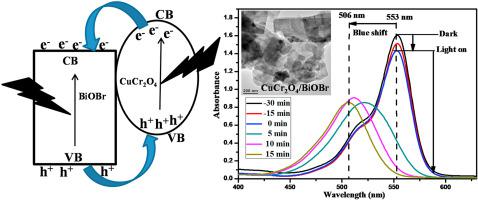当前位置:
X-MOL 学术
›
J. Alloys Compd.
›
论文详情
Our official English website, www.x-mol.net, welcomes your
feedback! (Note: you will need to create a separate account there.)
Facile synthesis of CuCr2O4/BiOBr composite and its photocatalytic activity towards RhB and tetracycline hydrochloride degradation under household visible LED light irradiation
Journal of Alloys and Compounds ( IF 5.8 ) Pub Date : 2020-11-01 , DOI: 10.1016/j.jallcom.2020.157947 Kalyan Ghorai , Monotosh Bhattacharjee , Debasish Mandal , Akbar Hossain , Trilochan Bhunia , Mrinmay Das , Partha Pratim Ray , Bibhutibhushan Show , Parthasarathi Bera , Tapas Kumar Mandal , Motin Seikh , Arup Gayen
Journal of Alloys and Compounds ( IF 5.8 ) Pub Date : 2020-11-01 , DOI: 10.1016/j.jallcom.2020.157947 Kalyan Ghorai , Monotosh Bhattacharjee , Debasish Mandal , Akbar Hossain , Trilochan Bhunia , Mrinmay Das , Partha Pratim Ray , Bibhutibhushan Show , Parthasarathi Bera , Tapas Kumar Mandal , Motin Seikh , Arup Gayen

|
ABSTRACT Here we report the development of CuCr2O4/BiOBr nanocomposite photocatalysts for the first time to serve the purpose of RhB and tetracycline hydrochloride (TC-HCl) degradation using household visible light emitting diode (LED) light. In this nanocomposite, sol-gel combustion made spherical shaped CuCr2O4 nanoparticles are decorated on BiOBr plates in single pot via precipitation method using cetyltrimethylammonium bromide (CTAB) as the Br source as well as the template. The present investigation highlights a significant advancement to tackle the challenge of visible light induced photocatalytic degradation of harmful organic dye RhB and antibiotic-pollutant TC-HCl. The 20%CuCr2O4/BiOBr nanocomposite exhibits high degradation activity for both RhB (96% in 15 min) and TC-HCl (96.7% in 300 min) in presence of LED light with good recycling characteristics. Detailed structural and optical characterization using XRD, BET, FESEM, TEM, HRTEM, EDX, XPS, UV−Vis DRS, PL spectroscopy and Raman spectroscopy have been carried out prior performing photocatalytic activity tests. The structural as well as optical data have revealed a significant improvement in visible light absorption of BiOBr in presence of CuCr2O4. Based on energy band modification at the heterojunction of nanocomposite materials and their radical trapping ability, a plausible mechanistic path of photocatalytic degradation is presented.
中文翻译:

CuCr2O4/BiOBr复合材料的简便合成及其在家用可见光LED光下对RhB和盐酸四环素降解的光催化活性
摘要 在这里,我们首次报告了 CuCr2O4/BiOBr 纳米复合光催化剂的开发,用于使用家用可见光发光二极管 (LED) 光降解 RhB 和四环素盐酸盐 (TC-HCl)。在这种纳米复合材料中,使用十六烷基三甲基溴化铵 (CTAB) 作为 Br 源和模板,通过沉淀法在单锅中的 BiOBr 板上装饰溶胶-凝胶燃烧制成的球形 CuCr2O4 纳米颗粒。目前的研究突出了在应对有害有机染料 RhB 和抗生素污染物 TC-HCl 的可见光诱导光催化降解挑战方面取得的重大进展。20% CuCr2O4/BiOBr 纳米复合材料对 RhB(15 分钟内 96%)和 TC-HCl(96. 7% 在 300 分钟内)在具有良好回收特性的 LED 灯的存在下。在进行光催化活性测试之前,已经使用 XRD、BET、FESEM、TEM、HRTEM、EDX、XPS、UV-Vis DRS、PL 光谱和拉曼光谱进行了详细的结构和光学表征。结构和光学数据表明,在 CuCr2O4 存在下,BiOBr 的可见光吸收显着改善。基于纳米复合材料异质结处的能带改性及其自由基捕获能力,提出了一种合理的光催化降解机理路径。结构和光学数据表明,在 CuCr2O4 存在下,BiOBr 的可见光吸收显着改善。基于纳米复合材料异质结处的能带改性及其自由基捕获能力,提出了一种合理的光催化降解机理路径。结构和光学数据表明,在 CuCr2O4 存在下,BiOBr 的可见光吸收显着改善。基于纳米复合材料异质结处的能带改性及其自由基捕获能力,提出了一种合理的光催化降解机理路径。
更新日期:2020-11-01
中文翻译:

CuCr2O4/BiOBr复合材料的简便合成及其在家用可见光LED光下对RhB和盐酸四环素降解的光催化活性
摘要 在这里,我们首次报告了 CuCr2O4/BiOBr 纳米复合光催化剂的开发,用于使用家用可见光发光二极管 (LED) 光降解 RhB 和四环素盐酸盐 (TC-HCl)。在这种纳米复合材料中,使用十六烷基三甲基溴化铵 (CTAB) 作为 Br 源和模板,通过沉淀法在单锅中的 BiOBr 板上装饰溶胶-凝胶燃烧制成的球形 CuCr2O4 纳米颗粒。目前的研究突出了在应对有害有机染料 RhB 和抗生素污染物 TC-HCl 的可见光诱导光催化降解挑战方面取得的重大进展。20% CuCr2O4/BiOBr 纳米复合材料对 RhB(15 分钟内 96%)和 TC-HCl(96. 7% 在 300 分钟内)在具有良好回收特性的 LED 灯的存在下。在进行光催化活性测试之前,已经使用 XRD、BET、FESEM、TEM、HRTEM、EDX、XPS、UV-Vis DRS、PL 光谱和拉曼光谱进行了详细的结构和光学表征。结构和光学数据表明,在 CuCr2O4 存在下,BiOBr 的可见光吸收显着改善。基于纳米复合材料异质结处的能带改性及其自由基捕获能力,提出了一种合理的光催化降解机理路径。结构和光学数据表明,在 CuCr2O4 存在下,BiOBr 的可见光吸收显着改善。基于纳米复合材料异质结处的能带改性及其自由基捕获能力,提出了一种合理的光催化降解机理路径。结构和光学数据表明,在 CuCr2O4 存在下,BiOBr 的可见光吸收显着改善。基于纳米复合材料异质结处的能带改性及其自由基捕获能力,提出了一种合理的光催化降解机理路径。


















































 京公网安备 11010802027423号
京公网安备 11010802027423号